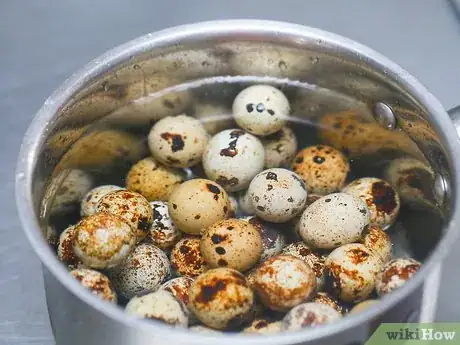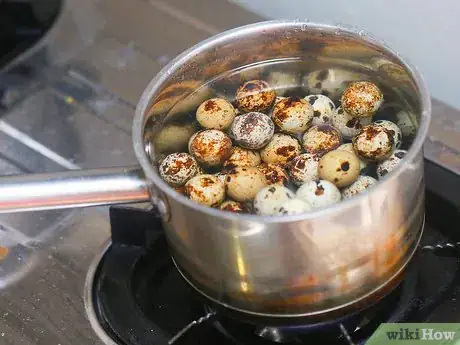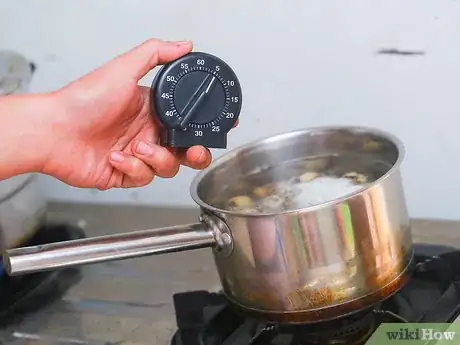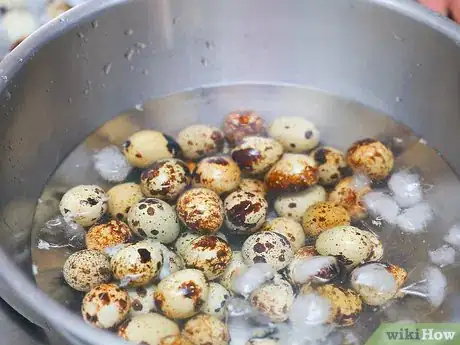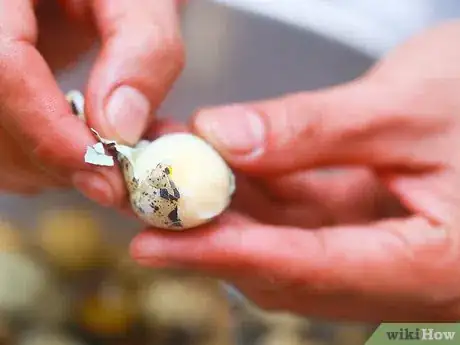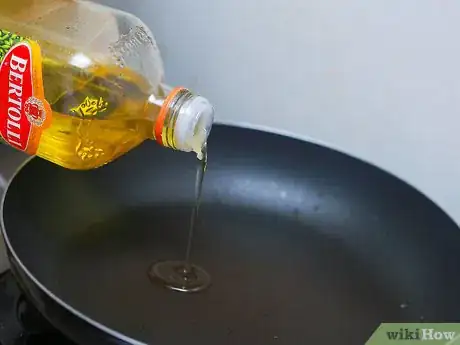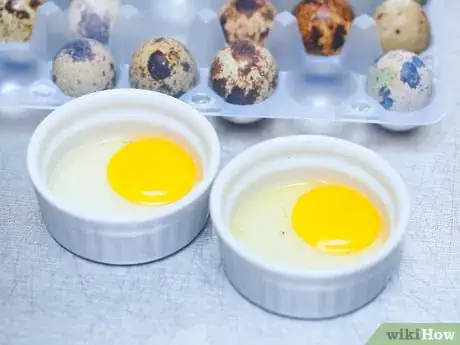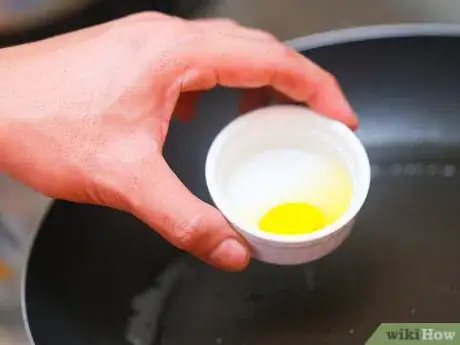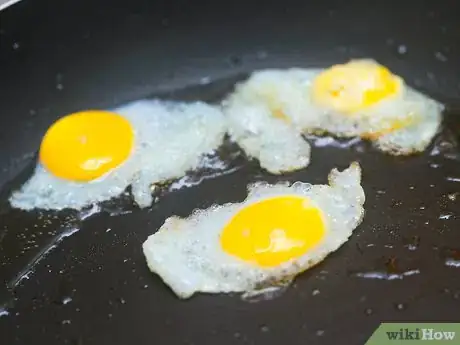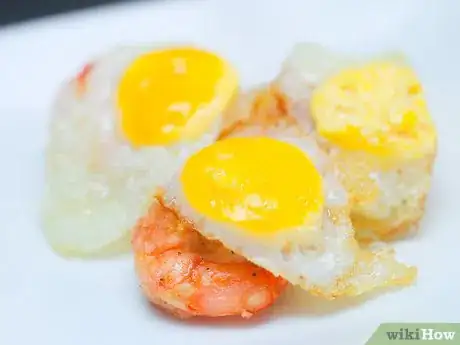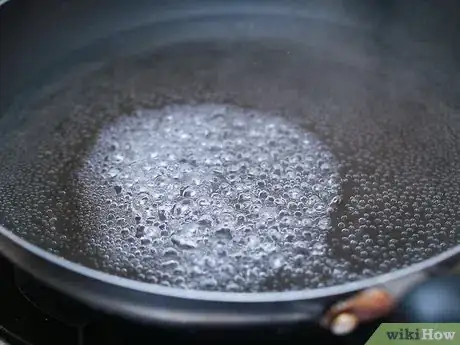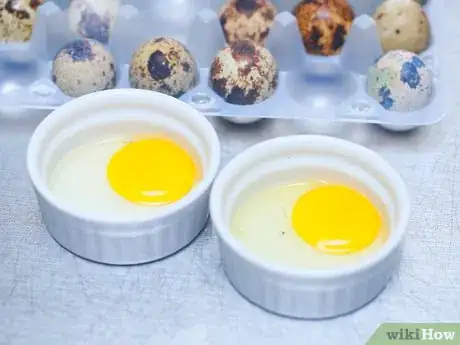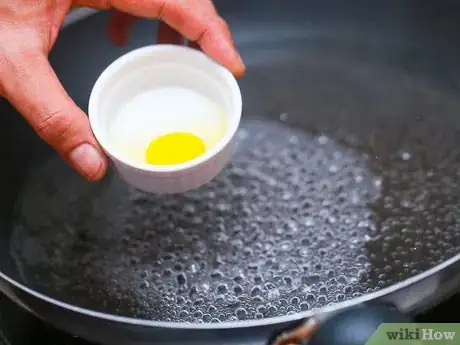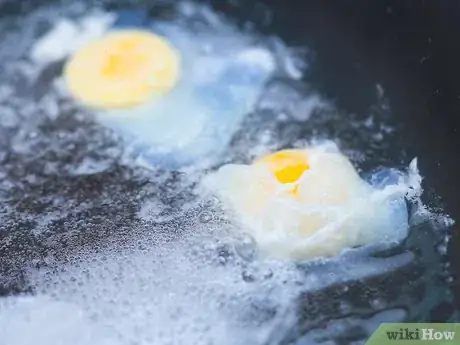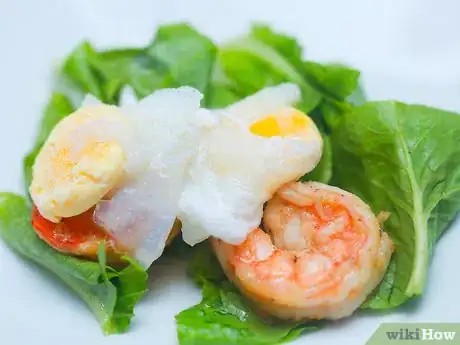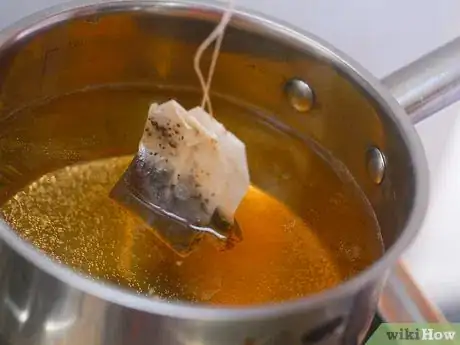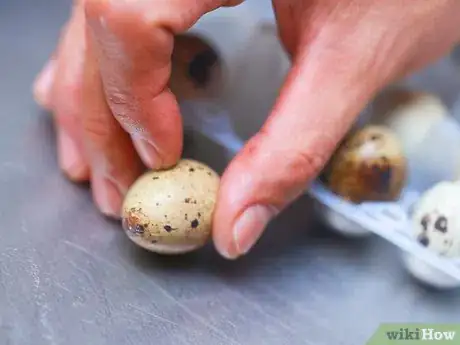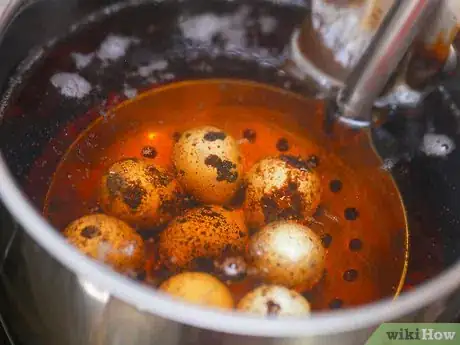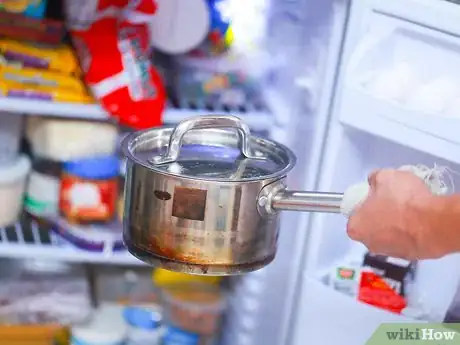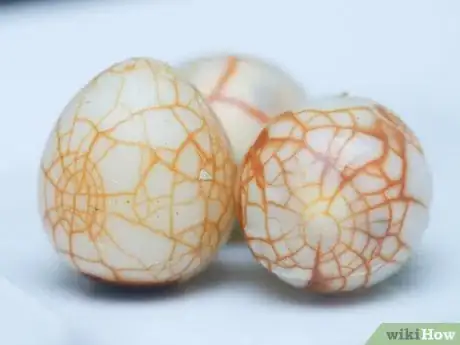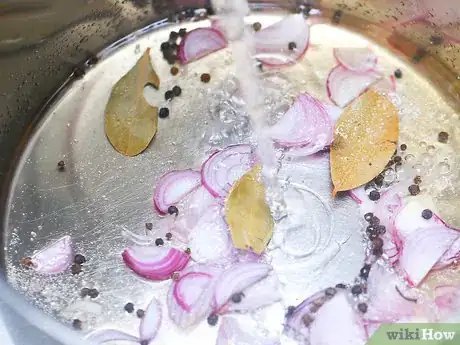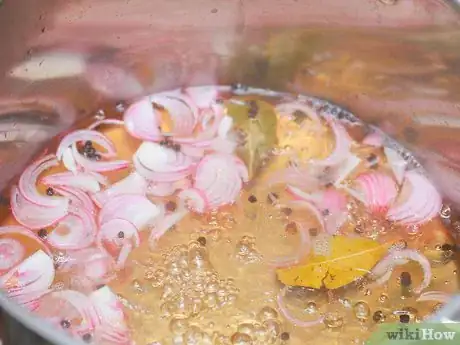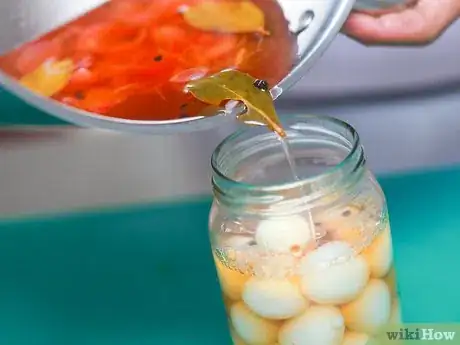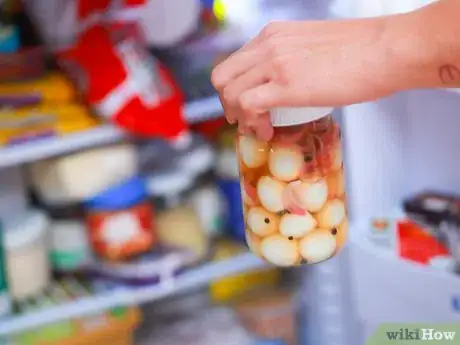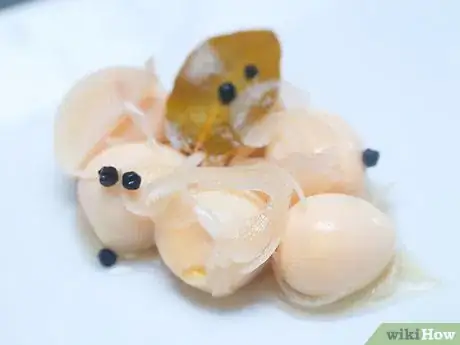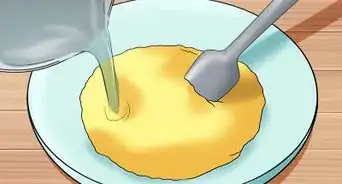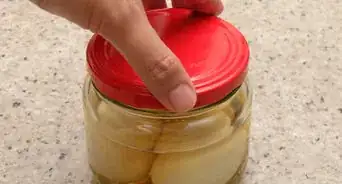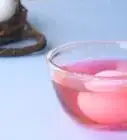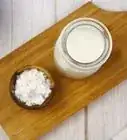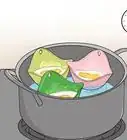wikiHow is a “wiki,” similar to Wikipedia, which means that many of our articles are co-written by multiple authors. To create this article, volunteer authors worked to edit and improve it over time.
wikiHow marks an article as reader-approved once it receives enough positive feedback. In this case, 90% of readers who voted found the article helpful, earning it our reader-approved status.
This article has been viewed 42,000 times.
Learn more...
Quail eggs are tiny and elegant, and they have a flavor similar to that of chicken eggs. They're most commonly hard boiled, fried, or poached. Hard boiled quail eggs can also be marbled, pickled, or included in other recipes.
Ingredients
Makes 6 servings
- 6 raw quail eggs
- 4 cups (1 L) water
- 4 cups (1 L) ice water
- 1 tsp (5 ml) white vinegar (optional)
- 1 tsp (5 ml) salt (optional)
Makes 6 servings
- 1 Tbsp (15 ml) vegetable oil
- 6 raw quail eggs
- Salt, to taste
- Ground white pepper, to taste
Makes 6 servings
- 6 raw quail eggs
- 2 cups (500 ml) water
- Salt, to taste
- Ground black pepper, to taste
Makes 6 servings
- 6 hard boiled quail eggs, shells intact
- 2 cups (500 ml) water
- 4 tea bags (passion tea, chai tea, black tea, oolong tea, or other dark/bright blend)
- 2 tsp (10 ml) honey
- 4 whole cloves
Makes 24 servings
- 24 hard boiled quail eggs, peeled
- 1/2 cup (125 ml) white wine vinegar
- 1/4 cup (60 ml) water
- 1/4 tsp (1.25 ml) celery seeds
- 1/4 tsp (1.25 ml) anise seeds
- 1/2 tsp (2.5 ml) fennel seeds
- 1/2 tsp (2.5 ml) whole black peppercorns
- 1/2 tsp (2.5 ml) coriander seeds
- 8 whole cloves
- 2 bay leaves
- 1/2 tsp (2.5 ml) paprika
- 1/2 tsp (2.5 ml) sea salt
- 2 shallots, sliced thinly
Steps
Hard Boiled
-
1Cover the eggs with cold water. Place the quail eggs in a small saucepan. Add enough cold water to cover the eggs by 1 inch (2.5 cm).
- Handle the eggs gently to prevent them from cracking. The eggs should remain in a single layer with some space between them; do not crowd or stack them.
- While not strictly necessary, consider adding 1 tsp (5 ml) salt and 1 tsp (5 ml) white vinegar to the water. Doing so can help separate the egg from its shell, making the eggs easier to peel later.
-
2Bring the water to a boil. Place the saucepan on the stove over medium-high heat. Allow the water to reach a steady boil.Advertisement
-
3Turn off the heat and cook for 5 minutes. As soon as the water reaches a boil, turn off the heat and cover the saucepan. Cook the eggs for an additional 5 minutes in the hot water.
- Leave the saucepan on the burner while the eggs finish boiling. The residual heat from the burner will help cook the eggs more thoroughly. Leaving the heat on could overcook the eggs, however.
-
4Submerge the eggs in cold water. Use a slotted spoon to transfer the eggs into a bowl of ice water. Cool the eggs for 3 to 4 minutes.
- Dunking the eggs in ice water stops the cooking process. It also makes the eggs easier to peel.
- If you don't have an ice bath, rinse each egg under cold, running water until the shells feel cool to the touch.
-
5Serve. Peel off the shell and enjoy the hard boiled quail eggs as desired.
- To peel the eggs, lightly tap the shell on a hard surface to break it. Lift away the shell at its cracks.
- You can serve the eggs plain with a little salt or celery salt for flavor. Alternatively, you can use hard boiled quail eggs in other recipes, like tea marbled eggs, pickled eggs, and kwek kwek.
Fried
-
1Heat the oil. Pour the oil into a large nonstick skillet. Set the pan over medium heat for approximately 1 minute.
- Let the oil get hot, but do not allow it to start smoking. When the oil starts to glisten, turn and rotate the pan to help spread the oil across the entire bottom.
-
2Crack the eggs. Carefully crack each of the quail eggs into separate ramekins.
- Since quail eggs are so small, they can be difficult to crack without breaking the yolk. The easiest way to break open the egg is to saw off the end using a serrated knife; dump the contents of the shell into the ramekin afterward.
- Alternatively, you can carefully peel off the end of the shell with your fingers and pinch the inner membrane to break the egg open. Pour out the contents from that hole.
- If you decide to cook more eggs than called for in this recipe, work in small batches, preparing about four eggs in each one.
- Since quail eggs are so small, they can be difficult to crack without breaking the yolk. The easiest way to break open the egg is to saw off the end using a serrated knife; dump the contents of the shell into the ramekin afterward.
-
3Slide the eggs into the oil. Pour each quail egg out of its ramekin, allowing it to gently slide into the hot oil in the pan.
- Place the edge of the ramekin as close to the pan as possible to minimize the drop distance and preserve the yolk.
- Try to position the eggs so that they do not touch inside the pan.
-
4Cook until firm. Cover the pan and cook the eggs for 1 to 1-1/2 minutes, or until the egg whites are firmly set.[1]
- Do not touch the eggs while they cook.
- Note that the yolk will not appear firmly set when the eggs are finished.
-
5Serve warm. Use a spatula to carefully lift each egg out of the skillet and onto separate serving plates. Season with salt and white pepper, and enjoy them while they're still warm.
- Fried quail eggs can be served as a standalone dish, but they're more commonly served over other dishes, like slices of baguette, smoked salmon, or crab cakes.
Poached
-
1Simmer the water. Fill a small frying pan with approximately 2 inches (5 cm) of water. Bring the water to a gently boil over medium-high heat.
- As soon as the water boils, turn down the heat so that the water is just barely simmering. The water must bubble at a gentle pace before you add the eggs.
-
2Meanwhile, crack the eggs. As the water boils, crack each of the eggs into separate ramekins.
- Open the eggs carefully to avoid breaking the yolk. Use a serrated knife to carefully saw through the shell and membrane at one end, then pour the inner egg into the ramekin through that opening.
- Ideally, you should only cook three to four eggs at a time. For larger amounts, you may need to work in batches.
-
3Slide the eggs into the water. Carefully pour each egg into the bubbling water. Space the eggs apart so that they do not touch one another.
- Position the edge of the ramekin as close to the surface of the water as possible before pouring in the egg. Doing so will allow the egg to gently slide into the water, thereby preserving the yolk.
-
4Cook until set. Cook the eggs for about 1 minute, or until the whites are set and the yolk has reached your desired level of doneness.[2]
- Use a spatula to carefully remove the finished eggs from the water. Transfer them to a plate lined with paper towels so that the water may drain.
-
5Serve warm. Serve the eggs immediately.
- Poached quail eggs are typically served atop simple green salads or cooked green vegetables, but you can also enjoy them separately.
- If you need to save the eggs for later, keep them in a bowl of ice water for up to several hours. Reheat the eggs in simmering water for 30 seconds, or until heated through, before serving.
Tea Marbled
-
1Simmer the water, tea, and spices. Pour 2 cups (500 ml) of water into a small saucepan. Add the tea bags, honey, and whole cloves to the water, then bring everything to a boil over medium-high heat.
- You can vary the type of tea and the types of spices used according to your own tastes, but stick with deep or bright colored teas to create more pronounced marbling.
-
2Crack the egg shells. While the tea boils, gently roll the hard boiled quail eggs over a hard surface, cracking the shells without peeling them off.
- Alternatively, you could also crack the shells by tapping them with the back of a spoon.
- The cracks must be deep enough to reach through the membrane and to the white of the inner egg, but the shells themselves should remain intact.
-
3Submerge the eggs in the tea. Turn off the heat but leave the the saucepan on the stove. Use a slotted spoon to gently lower the eggs into the hot tea.
- Cover the saucepan and allow the eggs to sit in the hot water for 20 to 30 minutes.
-
4Refrigerate overnight. Transfer the covered saucepan to the refrigerator and chill the eggs for at least 2 hours, if not overnight.[3]
- Longer steep time will usually result in more pronounced marbling. Notable marbling should occur after 2 hours, but the effect will be more pronounced after 8 hours.
-
5Peel and serve the eggs. Drain the tea, dry the quail eggs, and peel away the shells using your fingers. Serve the marbled eggs cool or at room temperature.
- The tea itself should add flavor to the eggs, but if desired, you could still serving the eggs with a sprinkling of Kosher salt, soy salt, or another type of dipping salt.
Pickled
-
1Combine the pickling ingredients. Pour the white wine vinegar into a small saucepan. Add the water, celery seeds, anise seeds, fennel seeds, peppercorns, coriander seeds, cloves, bay leaves, paprika, sea salt, and sliced shallots. Stir to combine.
-
2Boil the mixture. Place the saucepan on the stove over medium heat. Let it reach a boil, reduce the heat to medium-low, and continue simmering the mixture for 2 to 3 minutes.
- Afterward, remove the saucepan from the stove and set it away from the heat. Let it cool for 5 to 10 minutes, or until it drops close to room temperature.
-
3Cover the eggs with the vinegar mixture. Place the eggs in a sterilized 1-qt (1-L) jar. Pour the cooled vinegar mixture over the eggs.
- You must use a jar that's been cleaned and sterilized with boiling water. If harmful bacteria gets introduced into the mixture, the pickled eggs could become tainted and dangerous to eat.
-
4Refrigerate for 24 hours. Seal the container and place it in your refrigerator. Keep it there for at least 24 hours.
-
5Serve. Spoon the pickled quail eggs out of the vinegar mixture and enjoy them slightly chilled.
- You can enjoy the pickled quail eggs as snacks, appetizers, or side dishes.
- Store leftovers in the pickling liquid. Keep the container sealed and in your refrigerator, and use the eggs within two weeks.
Things You'll Need
Hard Boiled
- Small saucepan with lid
- Medium bowl
- Slotted spoon
Fried
- Large nonstick skillet with lid
- Serrated knife
- 6 ramekins
- Flat spatula
Poached
- Small frying pan
- 6 ramekins
- Serrated knife
- Flat spatula
- Plate
- Paper towels
Tea Marbled
- Small saucepan with lid
- Metal spoon
- Slotted spoon
- Paper towels
Pickled
- Small saucepan
- Mixing spoon
- 1-qt (1-L) glass jar with lid
- Ladle
- Refrigerator
References
About This Article
To fry quail eggs, start by heating 1 tablespoon of vegetable oil in a pan over medium heat. Then, crack the quail eggs into separate ramekins or bowls, and carefully pour each one into the pan so the yolk doesn't break. Next, cover the pan, and cook the eggs for 1 minute, or until the whites are firmly set. Finally, carefully transfer the fried eggs to a plate and enjoy. To learn how to poach and hard boil quail eggs, keep reading!
